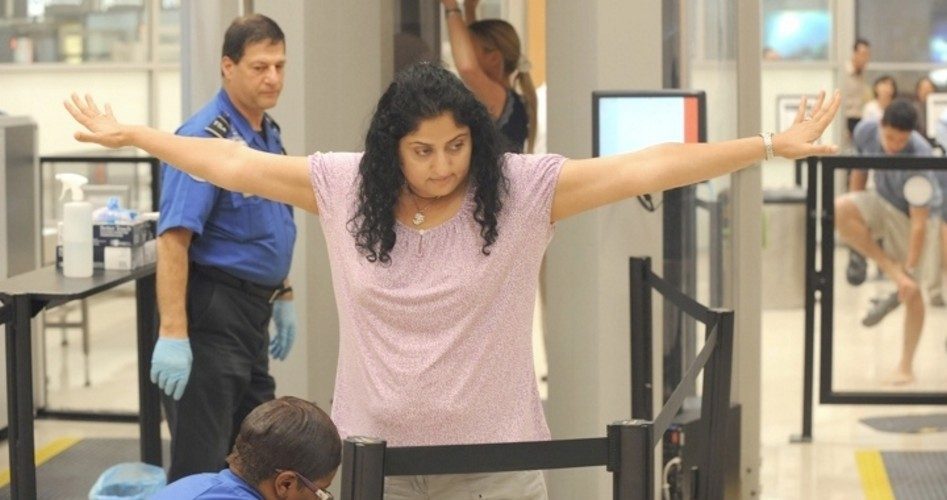
Finally responding to the harsh public backlash, the Transportation Security Administration is attempting to move away from the invasive “enhanced pat-downs.” Current TSA policy requires passengers who have been through the body scanners to be subjected to pat-downs if something is detected by the scanners.
Though the new measures being considered would apply solely to travelers who pass through body scanners, the TSA’s attempt to implement different procedures is indicative that some of the oppositional efforts against the overreaching federal agency may be working.
Government Security News reports:
In an effort to minimize the number of physical pat-downs that screeners must conduct at U.S. airports, DHS [Department of Homeland Security] is inviting R&D proposals from companies and organizations that can develop handheld devices that weigh less than five pounds and which could resolve “anomalies” detected when passengers are sent through Advanced Imaging Technology (AIT) equipment.
The TSA stipulates that such a handheld device be “capable of screening all areas of the body without removal of clothing beyond outwear.” Such technology, however, which typically involves the use of radiation, is likely to raise further concerns, particularly as the TSA is still contending with reports about the cancer-causing technology it currently uses.
Despite a report filed by ProPublica that the scanners could cause “anywhere from six to 100 U.S. airline passengers each year [to] get cancer,” plus a variety of expert testimonies on the dangers of the technology, and the fact that the European Union has banned the machines, the TSA has elected to continue the use of the scanners nationwide. As noted by The New American’s Michael Tennant, “What’s worse, the TSA has other, safer types of scanners, known as millimeter-wave scanners, that the agency says are as effective as the backscatter scanners; but it has chosen to continue deploying the backscatter scanners even though they could adversely affect the health of the flying public.”
The ProPublica report and a report featured by PBS NewsHour entitled “U.S. Government Glossed Over Cancer Concerns,” revealed that the Food and Drug Administration rejected the concerns of a 1998 expert panel that recommended the agency set a mandatory federal safety standard for the devices.
And these analyses say nothing of the problem of the machines’ ineffectiveness.
In a recent paper published by University of California physics professors Leon Kaufman and Joseph Carlson in the Journal of Transportation Security, the two assert that the body scanners can easily be fooled. Citing a variety of data, the writers make some surprising revelations, including,
It is very likely that a large (15-20 cm in diameter), irregularly-shaped, cm-thick pancake with beveled edges, taped to the abdomen, would be invisible to this technology — ironically because of its large volume, since it is easily confused with normal anatomy.
The paper adds, “It is also easy to see that an object such as a wire or a box-cutter blade, taped to the side of the body, or even a small gun in the same location, will be invisible.”
Engineer Jon Corbett proved essentially the same thing in a video he posted on YouTube, observing, “Yes that’s right, if you have a metallic object on your side, it will be the same color as the background and therefore completely invisible to both visual and automated inspection.”
What’s worse, as noted by the two University of California physics professors, is that the problem cannot be solved simply by raising the level of X-ray exposure:
Even if exposure were to be increased significantly, normal anatomy would make a dangerous amount of plastic explosive with tapered edges difficult if not impossible to detect.
Still, reducing the number of airport pat-downs — particularly of children and the elderly — is a positive step.
In 2010, experts at Child Lures Prevention (CLP) voiced serious concerns about applying pat-down procedures to children. According to the organization, in an effort to have children cooperate with the screenings, TSA officials decided to call the pat-downs “a game.” TSA regional security director James Marchand explained: “You try to make it as best you can for that child to come through. If you can come up with some kind of game to play with a child, it makes it a lot easier.”
But CLP’s Ken Wooden explains that telling a child they are participating in a game “is one of the most common ways” for sexual predators to engage children in inappropriate contact. Likewise, because children “don’t have the sophistication” to differentiate between the pat-down at the airport and sexual assault, the TSA procedures may desensitize them to sexual molestation.
There are numerous incidents from across the country of elderly travelers suffering indignities at the hands of the TSA as well, including the infamous pat-down of a 95-year-old woman last year during which she was forced to remove her diaper.
But a growing number of critics, including Senator Rand Paul (R-Ky.), contend that the TSA should be eliminated altogether. “It’s time to END the TSA and get the government’s hands back to only stealing our wallets instead of groping toddlers and grandmothers,” declares Paul.
But while Paul is calling for an end to the TSA and its constitutional violations, Rep. Mike D. Rogers (R-Ala.), chairman of the House Subcommittee on Transportation Security, has asserted that the TSA should be “smarter, leaner and tougher” — sentiments later echoed by Senator Diane Feinstein (D-Calif.).
Photo: Airline passengers go through the TSA security checkpoint at Hartsfield-Jackson Atlanta International Airport on August 3, 2011 in Atlanta.: AP Images



